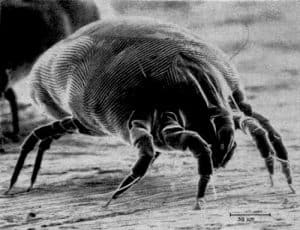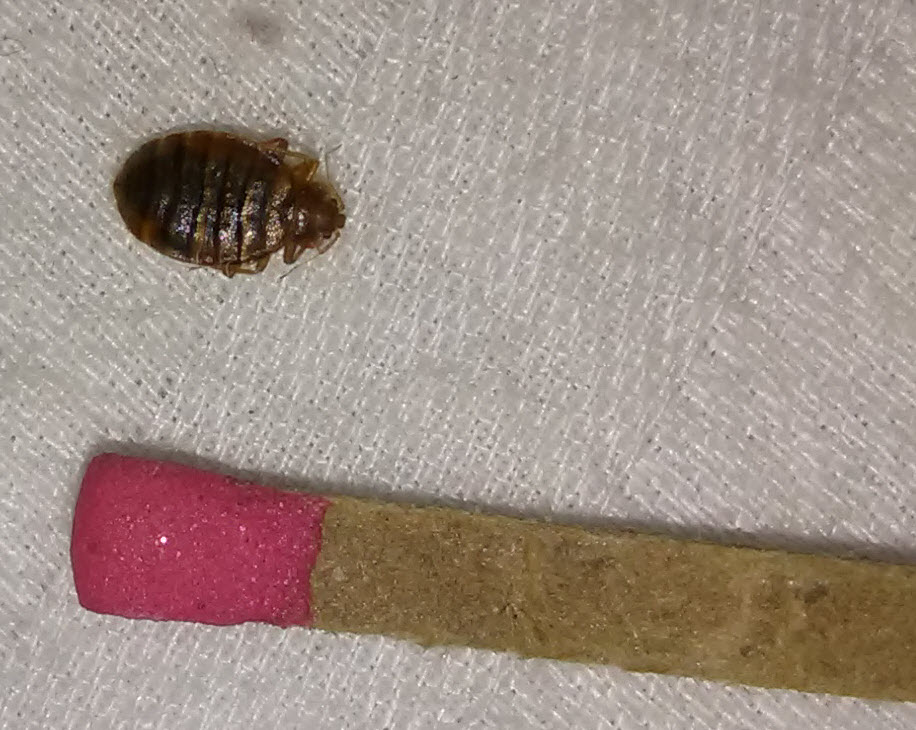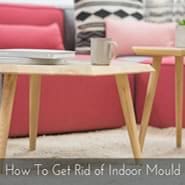First, we must start off by asking …
What Are Mites?
There are two types of bed mites:
Dust Mites
 Courtesy Mite Guard New Zealand
Courtesy Mite Guard New Zealand
These are opaque looking bugs. They eat skin cells, bacteria and pet hair. They’re microscopic ánd don’t bite. They absorb moisture, so they can be dehydrated. As well as they can also live for 70 days and tend to lay 20 eggs every 21 days.
Bed Bugs 
Courtesy BedBugs.org
These are a little less common in my experience. They are larger and they can be seen, so they surface a lot at night time and skim across the mattress. They feed on warm human blood.
These bugs BITE, so be careful. They also come out at from behind wall crevices and furnishing seams looking for human blood.
(When I was a kid we used to call them the travelling bug: they hop into your suitcase from infested places and travel back to your bedroom).
How Do You Get Rid Of These Mites
In order to kill these mites, you must take away their food supply. We know that dust mites eat your skin cells and bed bugs eat your blood. So, we need start by getting rid of the skin cells, and in order to do that, we must cover furnishings!
For this purpose, I would recommend covering your mattress and pillow and doona. That means for the amount of dust mites your bedding holds, you’ll be adding a dust mite cover for each piece of bedding. Dust mite covers must always be added to mattress, pillow and doona to prevent your skin cells feeding these dust mites.
It’s a good idea to buy your dust mite allergy covers in a set to save money and so it’s all covered. The allergy cover has a very tiny pore size which is perfect for stopping dust mites. Remember always keep your bed unmade during the day when the sun is up for the bed to dry most effective
PRODUCT:
Allerprotect Dust Mite Bed Set
Create a barrier between you and the dust mite allergens by enclosing the entire mattress, the entire pillow and the entire doona. Provides asthma and allergy relief by stopping the continual night time exposure to dust mite allergens while you sleep.

After you successfully cover your bedding, take your sheets and pillow and doona cases and wash them in hot water. This will loosen up any dust mites that have been living in there and drown them in hot water so that the heat has a better chance of killing them.
Note: Even if you don’t think you have mites, do this anyway just to be sure. Sometimes you might have increased numbers so small that you don’t even see them.
HOW TO:
How To Get Rid of Indoor Mould
Are you having guests coming over and now your indoors smell musty? Or are you the kind of person who constantly has black spots all on the walls no matter what you do? Does it seem like there is no way to get rid of the mould in your home?

The goal here is to get rid of the food supply for the dust mites. Without skin cells, the dust mites will have nothing to eat and will start dying off.
After you have covered your bedding, got your clean sheets on the bed and have replaced your pillow with a new one, make sure you get rid of all the bugs remaining. Since the dust mites need moisture to survive you can use this trick to kill them …
How Do You Kill These Mites?
Get new bedding, new mattress, pillow and doona. You can choose what suits you. Since these are new, the chemical smell, oops I meant the newness smell will out gas to the air. Vacuum using your HEPA filter vacuum both sides of the mattress, and put them in the dust mite cover. Close it up and wait for them to move elsewhere and you, stay healthy.
Sounds expensive I know, but it will get rid of them, the less mites, the less chances more mites will come.
Consider
To be honest with you, I had a really easy time writing this post because mites are interesting to me. (That is how I started Mitey Fresh in 1996, they are indeed curious). They are so minute and they’re everywhere. The pore size in the AllerProtect range of dust mite covers is so fine, 4.5 microns. They don’t stink of chemicals and you and a friend can put it straight onto the bed. I hope this helps you get rid of those that can ruin any sleep or health.
Just make sure you practice basic indoor air science and keep your space clean AT ALL TIMES.
 Towards healthier living Tony Parr 🙂
Towards healthier living Tony Parr 🙂
As Principal Consultant to Mitey Fresh since 1996, we have acquired knowledge of adverse health effects and recommend effective strategies to reduce occupants’ exposure by eliminating and controlling as many sources of pollutants in order to create healthy indoor living environments that are as exposure-free and natural as practically possible.
We cut out all the fluff and confusion of indoor air maintenance and stripped it down to the bare bones.
Some interesting facts
- Effective allergen avoidance requires a multifaceted, comprehensive approach; single steps alone are generally ineffective according to US Department of Health and Human Services National Institutes of Health (2007). Multifaceted allergen-control education programs provided in the home setting can help patients reduce exposures to cockroach, dust-mite, and rodent allergens and, consequently, improve asthma control.
- Studies, according to Vojta P.J. et al (2001), found both intensive vacuuming (using a power head) alone and dry steam cleaning plus vacuuming can result in significant reductions in House Dust Mite (HDM) allergens in bedroom carpet, with the combined modality producing a longer duration effect; b) impermeable covers combined with frequent washing of nonencased bedding materials can significantly reduce HDM allergen levels in the bed; and c) both intensive vacuuming and steam cleaning have a modest effect on HDM levels in upholstered furniture. Studies, according to Vojta PJ, et al (2001), found the professional laundry bedding regimen and the carpet steam cleaning plus vacuuming method are effective at decreasing HDM allergens to levels below those associated with increased asthma morbidity, but not below the 2 µg/g threshold proposed as an allergen sensitization risk factor. Studies concluded these physical interventions will likely have to be repeated often to maintain modest, long-term HDM allergen control.
- House dust mite (HDM) allergen levels are very high in homes in humid and coastal parts of Australia where epidemiologic studies have shown that exposure to HDM allergens is an important risk factor for asthma according to Peat JK, et al. (2001) and Platts-Mills TAE. et al. (2001).
- Avoidance of exposure to indoor allergens is an important element in the treatment of allergic disease. The greatest challenge is to educate allergic patients so that they can play an important role in controlling their own disease. (Platts-Mills et al. 2000).
References
- US Department of Health and Human Services National Institutes of Health, 2007, National Asthma Education and Prevention Program Expert Panel Report 3: Guidelines for the Diagnosis and Management of Asthma Full Report 2007 (Online). Available: https://www.nhlbi.nih.gov/files/docs/guidelines/asthsumm.pdf [17 April, 2015]
- Vojta PJ, Randels SP, Stout J, Muilenberg M, Burge HA, Lynn H, Mitchell H, O’Connor GT, Zeldin DC. Effects of Physical Interventions on House Dust Mite Allergen Levels in Carpet, Bed, and Upholstery Dust in Low-Income, Urban Homes Environmental Health Perspectives, 109(8): 815–819., 2001, (Online). Available: https://www.ncbi.nlm.nih.gov/pmc/articles/PMC1240409/pdf/ehp0109-000815.pdf [24 July, 2019]
- Peat JK, Tovey ER, Mellis CM, Leeder SR, Woolcock AJ. Importance of house dust mite and Alternaria allergens in childhood asthma: an epidemiological study in two regions of Australia. Clin Exp Allergy 1993;23:812-20. (Online). Available: https://www.ncbi.nlm.nih.gov/pubmed/10780887 [24 July, 2019]3a. Thomas A. E. Platts-Mills, MD, PhD, Daniel Vervloet, MD, Wayne R. Thomas, PhD,
Robert C. Aalberse, PhD, and Martin D. Chapman, PhD. Domestic control of house dust mite
allergen in children’s beds. J Allergy Clin Immunol 2000. (Online), Available: https://www.jacionline.org/article/S0091-6749(00)70048-0/pdf[24 July, 2019] - Platts-Mills TA, Vaughan JW, Carter MC, Woodfolk JA. The role of intervention in established allergy: avoidance of indoor allergens in the treatment of chronic allergic disease. J Allergy Clin Immunol 2000;106(5):787–804. (Online). Available: http://www.jacionline.org/article/S0091-6749(00)39663-4/fulltext [July 17, 2015]
Author
-
We’re glad you’re here. We’re Carol and Tony, founders of one of the longest running Healthy Home Blogs in the world, Mitey Fresh Australia. We’ve been on this journey for the last 25 years and are passionate about helping families sift through health hazards and triggers like allergens, mould, water damage, chemicals and EMFs, to get clarity about what’s toxic and what’s not so they can create a healthy and happy home for their family they love. Each month, people visit this blog seeking focus on the health and wellbeing of their loved ones, sustainable and effective practice tips and guides, to help create and manage healthier indoor spaces, improve the built environment that is pleasing to the senses and support healthy living and nature, every day. Starting this blog was to help change people’s lives, one family at a time, and we can’t wait to share how its allowed us to stand next to you and show you how interpreting these synergies between buildings and the environment they are built in will impact upon the health and well-being of those who occupy them. Find out more about Healthy Homes and what this blog can do for you!





